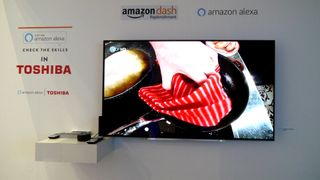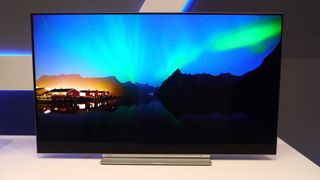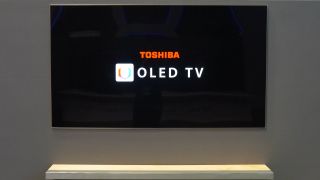Toshiba finally finds its voice with its Alexa-enabled OLED TV
Never leave the couch again

Talking to your TV certainly feels novel, and the announcement at Berlin's IFA conference that Toshiba is adding Amazon’s Alexa into its OLED, 4K HDR, and Full HD TV ranges absolutely plays into Toshiba’s goal to make the TV the entertainment center of the home once more.
From 2019, Toshiba's TV ranges will have Amazon Alexa built-in. With access to Amazon’s voice-activated assistant, the range will be able to deliver a wide range of features, some unique to the Smart TV, but also as part of Alexa’s wider skillset.
As of yet, Toshiba hasn’t divulged an official release date for Alexa integration, but the technology will be available from 2019.
Currently, Toshiba’s 65-inch OLED 4KHD TV retails for around $3900 (£3000 / AU$5300), while its 65-inch LED TV is considerably cheaper at around $900 (£700 / AU$1250) - you’ll have to wait until at least January if you want to experience the Alexa integration however.
Stunning clarity
We tried out the Alexa feature on one of Toshiba’s Ultra HD 4K OLED TVs. The display was stunningly clear, with an extremely thin, wall-mounted monitor, making it a fantastic choice for anyone short of space.
With super-thin edges, the TV offers completely distraction-free viewing away from any intrusive borders as well as making a cool, futuristic looking focal point for your living area. Colors were vivid, with brilliant contrast and picture clarity, making it an absolute joy to watch.
Although we saw the TV mounted on a wall, it does have a slim, silver stand, which looks really sleek and stylish. However the stand is quite narrow compared to the rest of the monitor, making it appear precariously balanced - we imagine most people would like to play it safe and have it fixed to the wall, as much for safety as for the aesthetic and space-saving benefits.
Get the best Black Friday deals direct to your inbox, plus news, reviews, and more.
Sign up to be the first to know about unmissable Black Friday deals on top tech, plus get all your favorite TechRadar content.
But that's enough about the TV, what about the voice?

When using the integrated Alexa feature for things like news and weather updates, the information comes up on a darker panel on the right-hand side of the screen, meaning that it doesn’t impede on whatever your watching while still being clear enough to read easily from your couch.
This side panel does disappear rather quickly however, so if you are trying to read information that Alexa has generated, you may find yourself having to ask for it multiple times just so you can finish reading, and this could be particularly troublesome for slower readers and people with bad eyesight.
"Alexa, change the channel"
We tested out a few simple commands, and found the far-field microphone was pretty adept at picking up our voices from across the room, although we did sometimes need to repeat ourselves. This was probably because of the Messe IFA is based in being so large. Alexa did have trouble picking up our voices when the TV was at a high volume, though, meaning it could benefit from a more powerful microphone.
We also saw Alexa responding to a number of different accents and it didn’t have any trouble recognising the commands, making it nice and accessible for those with regional accents.
Eliminating the remote control was definitely a novelty, and simple commands like ‘Alexa, turn the volume up’ were handled seamlessly. However, when we asked Alexa to change the channel, it didn’t understand the command, so it may be that you would need to familiarize yourself with the specific phrases it’s been taught to respond to.

As exciting as it is to tell your TV what to do, the need for a remote control becomes apparent as soon as you want to see what’s on across all channels and scroll through them - so it’s probably not a good idea to throw away your remote control just yet.
As well as TV-based features, Toshiba’s range of Alexa-enabled TVs will have access to Alexa’s entire skillset, meaning you can look up the weather, play music, and launch apps. We tested some of its pop culture knowledge by asking ‘Who is Michael Jackson?’
This brought up a neat little Wikipedia-style entry to the side of the screen, which is pretty handy if you ever need to settle couch side arguments about the age/marital status/nationality of different celebrities.
The future of TV
Being able to talk to your TV is exciting for even the most jaded of tech experts, and using Toshiba's Alexa-enabled OLED TV has really given us a glimpse into what the future of home entertainment will likely look like in a few years.
Still, there are a few issues with the technology which means it’s not the most seamless voice activated product we’ve seen before. Although Alexa appears to understand a number of different accents and languages, you still need to have a degree of specificity when making commands.
This is a problem with Alexa, and the wider world of voice-activated assistants rather than the TV itself, and as AI allows Alexa to learn as time goes on, we imagine that it will soon be able to understand more natural speech.
While it’s novel to not have to use a remote control, there is something to be said for the tactile nature of skipping through channels and feeling the buttons as you change the volume on your monitor - whether the general public will completely forgo the remote control in the near future is questionable, but it does seem to be the way televisions are heading.

We also felt that onscreen answers to commands should have remained onscreen for for longer - it seems as though most people would struggle to take in information fully in just a few seconds.
Hopefully in the future Toshiba will allow users to adjust how long information appears at the side of the screen, making it adaptable for anyone who needs a little longer to read.
However, we loved the novelty of asking your TV a question and having it respond via image and text, and could see how helpful this could be - how many times have you watched the news or a documentary and had to pause to look at your phone, frantically searching for information on the subject?
If Toshiba originally set out to make the TV the center of the home once more, it feels like they have succeeded with this integration.
Being able to make commands, ask questions, and launch apps without using an external device is quite liberating, and it encourages you to step away from the smartphone while watching your favorite show.
Whether swapping one screen for another is a good thing is yet to be determined, but 30 minutes away from social media temptation never did anyone any harm.
- IFA 2018 is Europe's biggest tech show. The TechRadar team is in Berlin to bring you all the breaking news and hands-on first impressions of new phones, watches and other tech as they're announced.
Olivia was previously TechRadar's Senior Editor - Home Entertainment, covering everything from headphones to TVs. Based in London, she's a popular music graduate who worked in the music industry before finding her calling in journalism. She's previously been interviewed on BBC Radio 5 Live on the subject of multi-room audio, chaired panel discussions on diversity in music festival lineups, and her bylines include T3, Stereoboard, What to Watch, Top Ten Reviews, Creative Bloq, and Croco Magazine. Olivia now has a career in PR.
Most Popular


